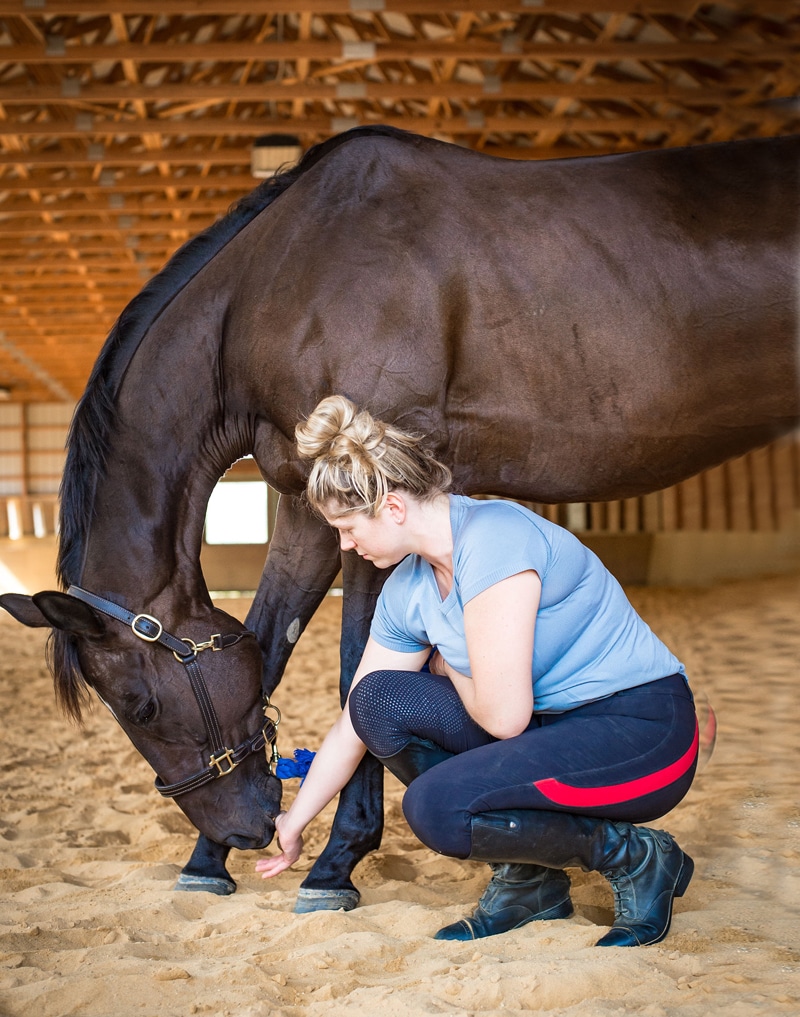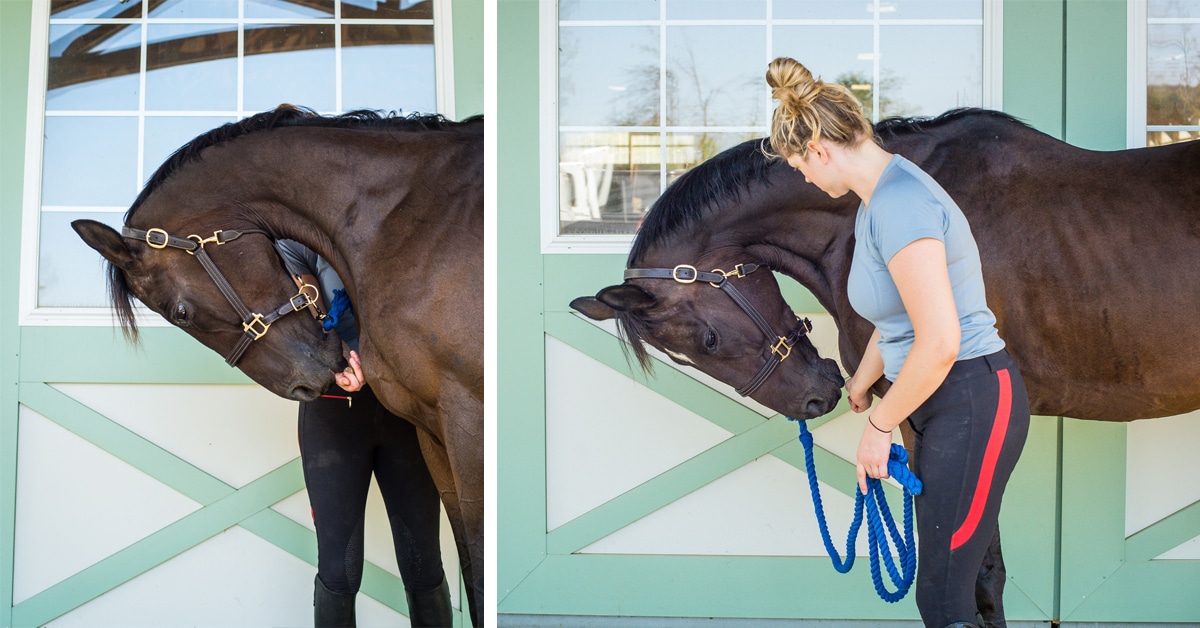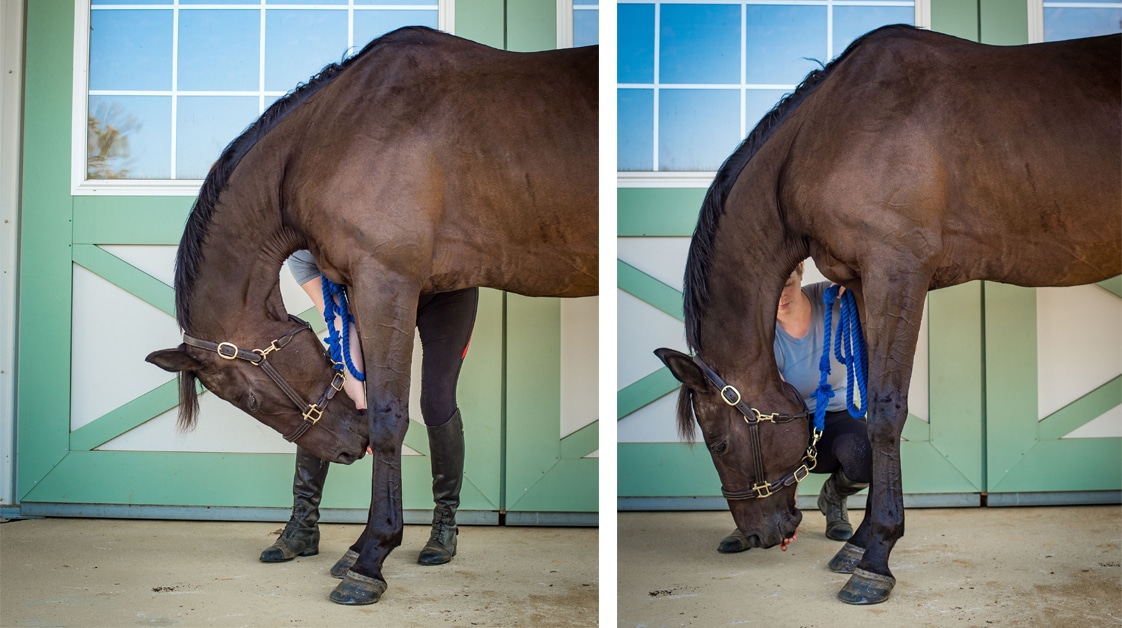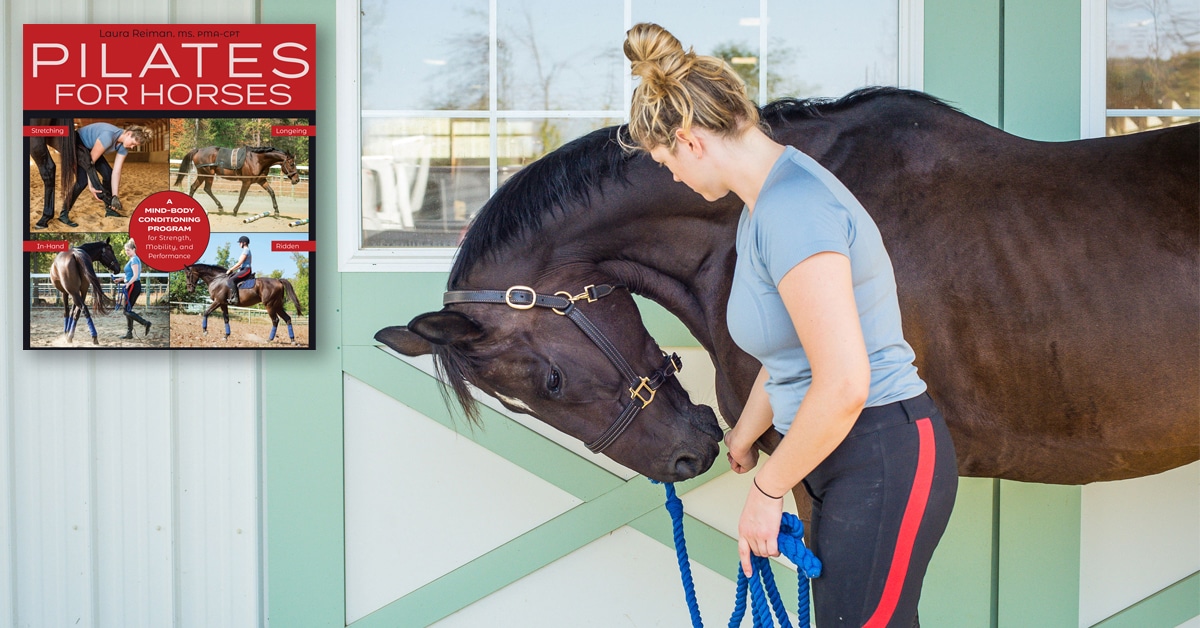Human athletes know that stretching is an invaluable part of any training program to keep muscles elastic, and a tight muscle is more prone to injury. Stretching helps to improve circulation, range of motion, and overall health of your horse’s muscles, while also decreasing muscle soreness and fatigue. As an added benefit, spending a few minutes stretching your horse can help create a stronger bond.

Incentive stretches, one of the three types of stretches described in the following pages, use treats or “incentives” to allow the horse to stretch himself. By elongating the neck, the back will also stretch, and the core will engage to stabilize, making this a full-body exercise.
WHAT
The three main stretches covered in this book—incentive stretches, supported static hold stretches, and dynamic mobilization stretches—are all techniques that pull your horse’s various limbs and muscles into a lengthened state to help increase mobility and flexibility, and release tension. When strengthening muscles, it’s important to also lengthen them to maintain suppleness.
Incentive stretches require the use of a treat or “incentive” to get your horse to stretch into a lengthened state on his own.
Supported static hold stretches require a handler to support the weight of the horse’s limb as it is pulled into a stretch.
Dynamic mobilization stretches increase range of motion through supported movements of the horse’s body.
WHY
- Increases range of motion, suppleness, and stride length.
- Reduces muscle soreness.
- Helps prevent muscle and joint strain.
- Eases tension in both the body and the mind.
- Increases body awareness and proprioception.
- Engages stabilizers, increasing balance.
- Increases circulation.
WHEN
- The benefit of stretching before work is that the horse will be more loose and supple for the riding session to come, but the muscles will be cold and mobility won’t be as accessible within the stretches.
- There is also a greater chance of strain when stretching before warming up. It is best to complete a stretching routine after work, as part of your horse’s cool-down.
- Ideally, stretches should be performed three to four times a week to prevent tightness.
- Hold each stretch for 10–20 seconds, especially when introducing a new technique, and work up to 45 seconds. Repeat 3–4 times on each side.
Tips for Stretches
- Stretches must always start slowly so that the body doesn’t clench in a “fight or flight” or protective response. You must ease into the stretch until you feel a light resistance and then hold, allowing the muscles to relax and elongate.
- Never drop a limb after stretching it—release it to the ground slowly. Never yank or use force when stretching, there should only be a light resistance against your pull.
Common Issues and Precautions
As with a human, too much mobility (hypermobility) can cause issues. If your horse can easily move into a full range of motion, strengthening the surrounding muscles of that joint should be prioritized over stretching.
STRETCH INTENSITY
The intensity of a stretch is considered the amount of force used to elongate the muscle, and less intensity is needed than you might think. Using too much force may strain or otherwise injure healthy tissue; keeping the intensity of these stretches to a light pull will be most beneficial for your horse.
Incentive Stretches
WHAT
Also known as “carrot stretches,” incentive stretches use treats or a clicker to ask your horse to stretch himself through flexion (rounding), lateral bending (side to side), and even extension (hollowing or reaching).
WHY
- Stretches the neck and back, increasing range of motion and suppleness.
- Improves strength and stability—especially in the core and topline.
- Reduces risk of injury.
- Increases bond between rider and horse.
TOOLS
- Treats. I don’t recommend using big carrots because horses can grab and hold them, engaging the jaw and neck muscles, which creates tension instead of release. A treat that your horse is overly fond of will make it harder to maintain his attention and more likely that he will lunge with his teeth. Find a food low in artificial sugar such as apple slices, celery, or smaller chunks of carrot to use. Low sugar Omega Nibblers® are also a great option.
- Gloves.
- Clicker if your horse becomes nippy.
WHEN
Stretches may be done every day, ideally after work when your horse’s muscles are warm.
Tips for Incentive Stretches
- Stand close to the horse and out of kicking range.
- Do not try stretches in an enclosed space like a wash stall; make sure there is room to step away if your horse loses balance.
- Don’t use the cross-ties when asking your horse to stretch. Ask a friend to hold the horse, perform the stretches in a big stall, or ground tie.
- If your horse tries to step back to follow the treat instead of stretching, ask for the stretch in front of a wall or have a friend place her hand on the horse’s hind end to discourage backward movement. Be patient and let your horse figure out what you’re asking.
- Don’t force these stretches. Allow the horse to be in control and do not pull him into position or hold his head down. Your horse is most likely already working hard to get the treat and needs time and repetition in order to go deeper in this position.
- Try different treats to see what works best. If you pick something your horse loves, like a Stud Muffin, he may lunge for the treat or become nippy.
- If your horse becomes nippy, especially when not asking for the stretch, spend some time training him to respond to a clicker.
Chin to Chest
WHAT
Ask your horse to bring his nose toward the center of his chest using a treat, creating flexion and stretch in the upper neck muscles.
WHY
Increases mobility in the upper and middle neck muscles, including the trapezius cervicis, cervical rhomboids, and splenius muscles.
HOW
1. Stand beside your horse, facing forward.
2. Offer a treat near the horse’s nose to get his attention.
3. Slowly move your hand back toward the center of the horse’s chest, covering the treat so he cannot grab it.
4. Make sure the horse’s neck is straight and his nose is pointing down.
5. When using a clicker, activate it right at the center of your horse’s chest.
6. Hold the stretch for 5 seconds to start, working up to 10-20 seconds over the course of several weeks.
7. Repeat 2-4 times, changing sides each time so your horse’s head doesn’t begin to tilt to one side in anticipation (images below).
WHEN
Every day, after your horse is warmed up. Hold for 10-20 seconds and repeat 2-4 times.

(Left) Mark is stretching his upper neck muscles. Even though he is stretching straight down, I make sure to repeat the stretch standing on both sides, to discourage any tilt of the head or neck. Notice I have my fingers closed around a treat so Mark stays interested and cannot grab the treat with his teeth (right). I trust that I can move quickly if Mark tries to bite the treat out of my hand, but this is not advised if your horse tends to lunge for treats.
Common Issues and Precautions
- When you hold the treat too high, the neck and jaw will tense, and the horse will not get the full benefit of the stretch. Holding the incentive at the middle of the chest elongates the muscles down the neck and through the back instead of just the poll.
- Refer to previous tips on this and other incentive stretches. Never hold your horse’s head down or force him into a greater range of motion than he offers.
Nose to Knees
WHAT
Ask your horse to bring his nose down toward his knees and eventually between them using a treat, flexing and stretching the neck and back.
WHY
- Increases mobility and encourages deep flexion of the middle and lower neck muscles, including the rectus capitus lateralis, multifidus cervicis, and serratus ventralis cervisis.
- Stretches the topline, loosening the rhomboids and trapezius muscles that wrap around the spinous processes at the withers.
- Strengthens flexion at the poll.
HOW
1. Stand to the side of your horse, facing forward.
2. Offer a treat near the horse’s nose to get his attention.
3. Slowly move your hand back toward the knees. If your horse is already flexible in this area, you can reach your hand behind your horse’s elbow and forward toward his nose, slowly pulling the treat back to the knees and then farther, between the knees and toward the belly.
4. Make sure your horse’s neck is straight, the nose is pointing down, and he is standing squarely with the front legs.
5. When using a clicker, activate it right between the horse’s knees.
6. Hold for 5 seconds to start, working up to 10-20 seconds over the course of several weeks.
7. Repeat 2-4 times, changing sides each time so your horse doesn’t begin to tilt to one side in anticipation.
WHEN
Every day, after your horse is warmed up. Hold for 10-20 seconds and repeat 2-4 times.
Common Issues and Precautions
- It’s okay for your horse’s knees to bend, but this can be a compensation that takes away from the stretch.
- Start by asking for less of a stretch, and work into a deeper flexion slowly.
- Refer to previous tips and precautions.

(Left) Nose To Knees: This stretch elongates the mid and lower neck muscles, as well as the entire topline of the body. Notice Mark’s knees are straight, he is standing squarely, and he is reaching straight down. (Right) Nose To Toes: Mark is stretching his deep neck flexors, lower neck muscles, and back, as well as engaging his core. I am not asking for a deeper bend toward the toes because I want to avoid any potential compression in the neck and shoulders.
Nose to Toes
WHAT
Ask your horse to bring his nose down toward his front feet using a treat, flexing and stretching the neck and back.
WHY
- Increases mobility and encourages deep flexion of the rhomboid muscle as well as the lower neck muscles, including the brachiocephalicus, sternocephalicus, and omohyoid muscle.
- Stretches the back, especially through the thoracic region.
- Activates stabilizers in both the front and hind end, and engages the abdominals.
HOW
1. Stand to the side of your horse, facing forward.
2. Offer a treat right in front of your horse’s nose to get his attention.
3. Slowly move your hand back toward the body and down toward the ground. If the horse is already flexible in this area, you can reach your hand behind the elbow and forward toward the nose, slowly pulling the treat down to the feet and then back between them.
4. Make sure your horse’s neck is straight, the nose is pointing down, and he is standing squarely with the front legs.
5. When using a clicker, activate it directly between the front feet.
6. Hold for 5 seconds to start, working up to 10–20 seconds over the course of several weeks.
7. Repeat 2–4 times, changing sides each time to give the muscles time to recover.
WHEN
Every day, after your horse is warmed up. Hold for 10–20 seconds and repeat 2–4 times.
Common Issues and Precautions
- Don’t allow your horse to flex too much at the poll. Ask the horse to reach out and then down.
- It’s okay for your horse’s knees to bend, but this can be a compensation that takes away from the stretch. Start by asking for less of a stretch and work into a deeper flexion slowly.
- Refer to previous tips and precautions above.
***
Pilates for Horses: A Mind-Body Conditioning Program for Strength, Mobility, and Performance by Laura Reiman, MS, PMA-CPT is available from Trafalgar Square Books here for $26.95 (USD).

